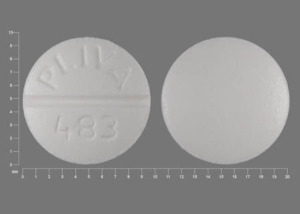Theophylline and Alcohol/Food Interactions
There are 3 alcohol/food/lifestyle interactions with theophylline.
Theophylline Caffeine
Moderate Drug Interaction
Ask your doctor before using theophylline together with caffeine. Using these medications together may increase some of the side effects of theophylline. This can cause nausea, vomiting, insomnia, tremors, restlessness, uneven heartbeats, and seizure (convulsions). Avoid drinks or foods that contain caffeine, such as coffee, tea, cola, and chocolate. You may need a dose adjustment or special test if you use both medications. It is important to tell your doctor about all other medications you use, including vitamins and herbs. Do not stop using any medications without first talking to your doctor.
Theophylline Food
Moderate Food Interaction
Both smoking and excessive caffeine consumption can alter the blood levels of theophylline, which may affect the dosing. Tobacco and marijuana smoke (including secondhand exposure) generally reduces, while caffeine increases, blood levels. In addition, caffeine is a stimulant and may add to the side effects of theophylline such as headache, insomnia, and increases in blood pressure and heart rate. It is best to avoid smoking and to limit caffeine consumption during theophylline therapy. Talk to a healthcare professional if you have any questions or concerns. If you start smoking or undergo smoking cessation, your doctor may need to monitor your blood levels more closely to determine if you need a dose adjustment of theophylline. You should stop taking theophylline and seek medical attention if you experience potential signs and symptoms of excessive drug levels such as nausea, vomiting, persistent headache, insomnia, and rapid heartbeat. It is important to tell your doctor about all other medications you use, including vitamins and herbs. Do not stop using any medications without first talking to your doctor. When theophylline is given with enteral (tube) feedings, blood levels may be decreased due to interference with its absorption. This may reduce the effectiveness of the medication. To minimize potential for interaction, you may interrupt the feeding for one hour before and one hour after the theophylline dose. You may need more frequent blood tests to monitor theophylline levels.
Switch to professional interaction data
Theophylline High Blood Pressure (Hypertension)
Moderate Potential Hazard, Moderate plausibility
methylxanthines - tachyarrhythmias
The use of theophyllines is associated with an increase in heart rate which may progress to supraventricular tachycardia or ventricular arrhythmia at high serum drug concentrations. Appearance of cardiac adverse effects is generally an indication of theophylline toxicity, although patients with a history of tachyarrhythmias may be more susceptible to the chronotropic effect of these drugs. Therapy with theophyllines should be administered cautiously in such patients. Caution is also advised in patients with hypertension, hyperthyroidism, angina pectoris, or recent myocardial infarction, since high dosages of the drugs are associated with positive inotropic as well as chronotropic effects. Clinical monitoring of serum drug concentrations is recommended to prevent toxicity.
Switch to professional interaction data
Theophylline drug interactions
There are 318 drug interactions with theophylline.
Theophylline disease interactions
There are 7 disease interactions with theophylline which include:
More about theophylline
- theophylline consumer information
- Check interactions
- Compare alternatives
- Pricing & coupons
- Reviews (17)
- Drug images
- Side effects
- Dosage information
- During pregnancy
- Drug class: methylxanthines
- Breastfeeding
- En español
Related treatment guides
Drug Interaction Classification
| Highly clinically significant. Avoid combinations; the risk of the interaction outweighs the benefit. | |
| Moderately clinically significant. Usually avoid combinations; use it only under special circumstances. | |
| Minimally clinically significant. Minimize risk; assess risk and consider an alternative drug, take steps to circumvent the interaction risk and/or institute a monitoring plan. | |
| No interaction information available. |
Further information
Always consult your healthcare provider to ensure the information displayed on this page applies to your personal circumstances.


